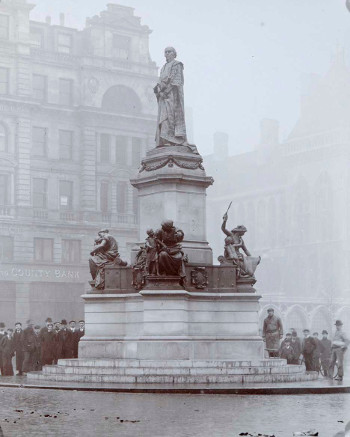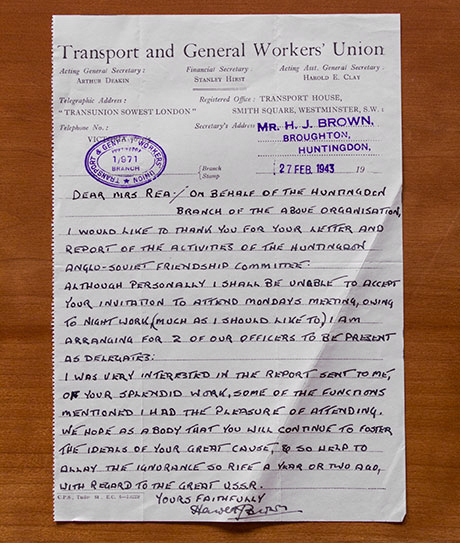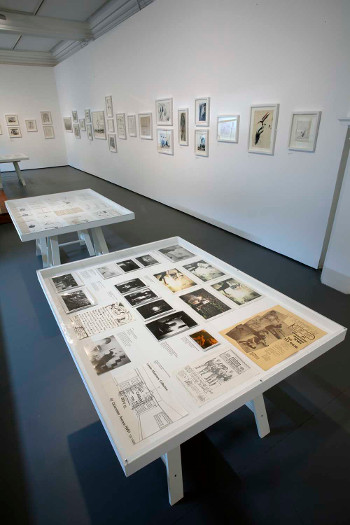Archives Hub feature for April 2016
The Henry Moore Institute is a world-recognised centre for the study of sculpture in the heart of Leeds. An award-winning exhibitions venue, research centre, Library and Archive of Sculptors’ Papers, the Institute hosts a year-round programme of exhibitions, conferences and lectures, as well as developing research and publications, to expand the understanding and scholarship of historical and contemporary sculpture. The Institute is part of the Henry Moore Foundation, which was set up by Moore in 1977 to encourage appreciation of the visual arts, particularly sculpture.
Henry Moore (1898–1986) studied in Leeds at the city’s School of Art (now known as Leeds College of Art) in 1919 and was always grateful for the quality of art education he received. In 1982, through his Foundation, investment was made in Leeds City Art Gallery to establish the Henry Moore Centre for the Study of Sculpture (HMCSS) which built on the existing sculpture collection by diversifying and collecting works on paper and preparatory archive material.
In 1993 the Henry Moore Foundation funded refurbishment by architects Dixon Jones of the building next to the City Art Gallery to house the HMCSS, named the Henry Moore Institute, which offered new galleries, conference facilities and new accommodation for the Research Library and Archive of Sculptors’ Papers. Since 1993 the Henry Moore Institute Research Library and Archive have continued to play a crucial role in the work and endeavours of the Institute as intended by Moore, providing an important research facility to enable a greater understanding of the history and practice of sculpture. Leeds Museums and Galleries owns the Archive which the Institute houses and maintains, in addition to managing the closely related Leeds Sculpture Collections, in a unique partnership that has built one of the largest public collections of British sculpture.

The Henry Moore Institute Archive is a specialist repository for papers relating to sculpture in Britain and has material dating from the eighteenth century to the present day with a particular emphasis on the period post-1880. The Archive now comprises over 300 individual collections which contain a diverse range of material including the personal papers of sculptors, correspondence, diaries, important collections of photographs, casting ledgers, sketchbooks and works on paper, press cuttings and printed ephemera. The collection is used extensively for research, display and features in many publications related to sculpture and other related disciplines.
The following collections from the Archive demonstrate the extent, variety and unique nature of the material held:
The Thornycroft Family Papers
The first major acquisition by the Henry Moore Institute Archive was the Thornycroft family papers in 1986. The papers are a rare survival which document the work of three generations of nineteenth and early twentieth-century artists. John Francis (1780–1861), was the first of the three generations, a portrait sculptor who exhibited extensively at the Royal Academy. John Francis taught his daughter, Mary (1809–95), who became a successful sculptor and produced many commissions for Queen Victoria. Her husband, Thomas Thornycroft (1815–85), was one of her father’s pupils, who specialised in public commemorative sculpture and completed many statues of Prince Albert.

Image courtesy of Leeds Museums and Galleries (Henry Moore Institute Archive).
Their youngest son, Sir William Hamo Thornycroft (1850–1925), also trained as a sculptor and his papers form the main part of the family’s collection. The papers of Hamo Thornycroft are important for their extensive scope and for the fact that they document the everyday activities of one of the foremost practitioners of the New Sculpture movement. The collection provides detailed documentation of all his major works, including ‘The Mower’ from 1884, a maquette for which is held in the Leeds Sculpture Collections. The collection is extremely comprehensive and consists of approximately 3,000 items of correspondence, 32 sketchbooks, 300 drawings which range from initial sketches and life drawings to presentation drawings and architectural plans for his work, as well as over 300 photographs of his work, studio and personal family photographs.
Papers of Betty Rea
The representation of female artists within the collection is a continuing area of development. Among current holdings is the archive of Betty Rea (1904–65). Rea was a sculptor who favoured realist sculpture in a period when abstract modernism held sway. Her sculptures tenderly celebrate quotidian life, whether by depicting teenage girls rocking with laughter or women completing household tasks, as can be seen in works such as ‘Silly Girls’ (1959) or ‘Folding a Carpet’ (1956). Betty Rea’s archive gives an interesting glimpse into both her artistic practice and the social and political world in which she lived. The contents of this collection can be considered as representative of the contents of many other collections. For example, the Betty Rea archive contains an album of photographs and over 200 loose photographs that record Rea and her sculptural process, a selection of correspondence that refer to the organisation of exhibitions, exhibition catalogues, private view cards, press cuttings largely relating to exhibitions Rea was involved in and one of her sketchbooks.
Material from the Henry Moore Institute Archive is frequently drawn upon and used to inform exhibitions held at the Institute as well as other institutions. For example, in 2005 the Institute curated the exhibition Jaki Irvine: Plans for Forgotten Works. This exhibition, held in Gallery 4, displayed a series of works created by Jaki Irvine as a result of her Fellowship at the Henry Moore Institute in 2004. During her Fellowship, Irvine engaged with some of the least expected areas of the Institute’s archive and material relating to the life and work of Betty Rea particularly captured her interest. Read more about this exhibition and Jaki Irvine’s Fellowship here: http://www.henry-moore.org/hmi/exhibitions/past-exhibitions/2005/jaki-irvine-plans-for-forgotten-works

Image courtesy of the Estate of Betty Rea and Leeds Museums and Galleries (Henry Moore Institute Archive).
Stephen Cripps Archive

Image courtesy of the Henry Moore Institute. Photo: Jerry Hardman-Jones.
More recent acquisitions include the archive of British sculptor and performance artist Stephen Cripps (1952-82) which was acquired in 2013, and provides a fascinating insight into Cripps’ artistic practice. His work was experimental and often included found objects, sound recordings from the urban environment around him and explosives. In 2013 the Institute curated the exhibition Stephen Cripps: Pyrotechnic Sculptor which was held in the Sculpture Studies Galleries of Leeds Art Gallery.
This exhibition celebrated the acquisition of the Cripps’ archive and utilised items from the collection, such as his drawings and photographs of his performances, to explore the originality and experimental nature of Cripps’ sculptural work.

The scope of the Henry Moore Institute Archive holdings can be viewed through an A to Z of collections on our website: https://www.henry-moore.org/hmi/archive/archive-collections-a-z. We began adding descriptions to the Archives Hub at the end of 2015 and now have over twenty-five of our collections available to search through the Hub.
The Archive is open to all who wish to consult the collection. Please contact Claire Mayoh, Archivist, for further information about the collection or to arrange an appointment to visit, (claire@henry-moore.org).
Katie Gilliland
Library, Archive and Collections Trainee
Henry Moore Institute
Browse the collections on the Archives Hub
